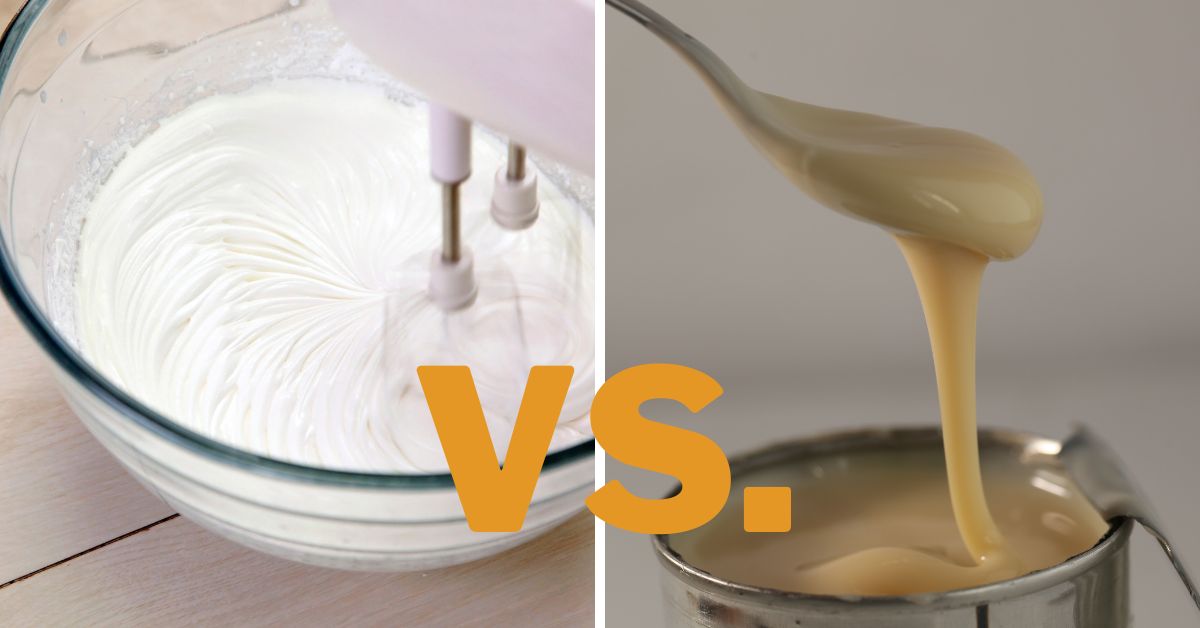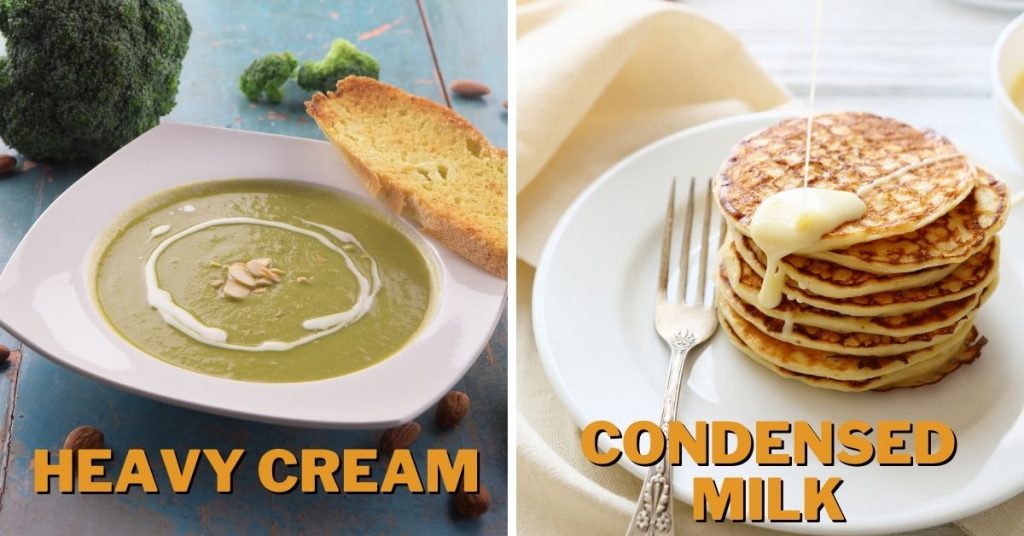Heavy Cream vs. Condensed Milk: Differences & Uses

When you look up dessert recipes, you will often notice that different recipes use different dairy products. Some call for sour cream, some specify whipping cream, light cream, clotted cream, etc. So, let’s look at heavy cream and condensed milk in particular. How are they different from each other? And how are they used?
Heavy cream is cream that contains at least 36% of fat while condensed milk is milk where most of the water has been removed. Condensed milk includes added sugar but heavy cream is usually unsweetened. Heavy cream is used for savory and dessert dishes. Condensed milk is used in beverages and desserts.
In this article, we will look in-depth at how these two dairy products differ from each other, how they are made, and how they are typically used. We will also discuss possible substitutes for both and whether or not you can use one for the other.
Heavy Cream vs. Condensed Milk: Differences
Before explaining their differences in detail, here is your cheat sheet that can help you differentiate between heavy cream and condensed milk.
| Feature | Heavy cream | Condensed milk |
|---|---|---|
| Key characteristic | At least 36% fat present | Water has been reduced by almost 60% |
| Preparations | Separating the fat from skim milk. | Reducing the water with heat |
| Sweetness | Slightly sweet | Very sweet |
| Appearance | Thick, white | Glossy, caramelized |
| Use | In both savor dishes and desserts | Used in beverages and desserts. |
Classification
Heavy Cream
When you classify a cream product, you have to look at the amount of milk fat present in them. Different cream gets different names depending on their fat content as well as the region it is from.
In the US, in order for a cream to qualify as heavy cream, it has to contain at least 36% milk fat. Any less than that and the product becomes “whipping cream”. The rest of the product is made up of water, protein, and carbohydrates.
Condensed Milk
As the name suggests, condensed milk is a concentrated form of milk where you remove almost 60% of the water. The remaining liquid is mostly protein, carbohydrates, and fat. So, it has a thick and glossy appearance.
Production
Heavy Cream
There are a few ways you can get cream from milk. The most common method in industrial production of cream is with the help of machines called “separators”. In unhomogenized milk, the fat particles eventually rise to the top. This is because fat particles are not too keen on mixing with water. So, you get an upper fat layer and a lower skim milk layer.
This upper layer of fat is what we call cream. The separator machines accelerate this process and then separate the cream layer from the top, leaving only the skim milk. Manufacturers then process the cream further and package the product in cans, tubs, or cartons.
Condensed Milk
To make condensed milk, you first need to heat milk to 85 to 90 °C and keep it there for several seconds. This does a couple of things. First, and most notably for condensed milk production, it evaporates much of the water. It also stabilizes the fat so that it does not separate from the mixture. It also kills some microorganisms and sterilizes the milk.
Then manufacturers add sugar to the liquid to make sweetened condensed milk. Almost all commercial condensed milk is sweetened. So, when a recipe says condensed milk, it is referring to “sweetened condensed milk”.
Taste
Heavy cream has a rich, luscious flavor thanks to its high fat content. It has a smooth yet heavy texture. In contrast, while condensed milk certainly has a thick consistency, it is not as rich or creamy as heavy cream.
Another thing to note is the sweetness. Heavy cream is not sweetened during manufacturing. So, the sweetness it has is pretty mild. But condensed milk has a very sweet taste.
Appearance
Just from looking at a far, you can tell which one is the cream product and which one is milk. Heavy cream is a thick, white liquid. Condensed milk, on the other hand, has a glossy, silky smooth appearance.
In fact, from a distance, heavy cream looks closer to whole milk than condensed milk. This is thanks to the sugar present in condensed milk, which caramelizes upon heating. Thus, the complexion of the milk turns glossy and brown. The production of heavy cream does not involve any heating and it has little to no sugar. So, it maintains its clear white hue.
Use
One of the primary applications of heavy cream is to convert it into whipped cream. For you to whip any cream into a stable foam, there has to be at least 30% fat in the product. Otherwise, the structure will fall on itself and turn into liquid again. Since heavy cream needs to have 36% fat minimum – and it usually has more than that – you can easily whip it.
This is why heavy cream has another name – heavy whipping cream. You really cannot do this condensed milk as the fat content is typically 8 to 9%.
Heavy cream also sees use in both savory and sweet dishes. You can use it to make fruit custard, pie filling, buttercream frosting, etc. But you can also add it to sauces and soups to make them richer and creamier.
Condensed milk is typically relegated to desserts due to it being so sweet. Many people, especially in Asia, put a scoop of condensed milk in their tea or coffee. People also put condensed milk in desserts for both its sweetness and milky flavor.

Nutrition
For this comparison, we are going to look at 100 grams samples of both heavy cream and condensed milk each. [1] [2] Note that these are the average estimated nutritions of such products and not any specific product.
| Nutrition | Heavy Cream | Condensed Milk (sweetened) |
|---|---|---|
| Calorie | 340 kcal | 321 kcal |
| Total carbohydrates | 2.84 g | 54.4 g |
| Added sugar | 2.84 g | 54.4 g |
| Total fat | 36 g (minimum) | 8.7 g |
| Saturated fat | 23 g | 5.5 g |
| Unsaturated fat | 13 g | 3.2 g |
| Protein | 2.84 g | 7.91 g |
| Calcium | 66 mg | 284 mg |
| Iron | 0.1 mg | 0.19 mg |
| Cholesterol | 113 mg | 34 mg |
Variations
When it comes to condensed milk, there are two varieties you will commonly encounter – the sweetened version and the unsweetened versions. In most cases, when people talk about condensed milk, they mean the sweetened version. Unsweetened condensed milk has another name altogether – evaporated milk.
Since there is no upper limit to the fat content in heavy cream, different countries have their own versions of it. In the US, heavy whipping cream has 36 to 40% fat. The European and English equivalent to this would be double cream, which has 48%. If you go one step further, you get clotted cream, which is 55% fat.
Heavy Cream vs. Condensed Milk: Which Is Better?
In terms of use, heavy cream is more versatile and flexible than condensed milk. You can use this cream in both savory dishes and desserts. Since it has no added sugar, you can freely control the sweetness of your dish.
But condensed milk has a rich, caramelized flavor that you cannot replicate with just heavy cream. And since it is already sweetened, you do not have to add extra sugar to your dish or beverage.
Can You Replace Heavy Cream with Condensed Milk?
You can use condensed milk in place of heavy cream, but only if the dish you are making is sweet. Remember, condensed milk is very sweet. And if you do not want that in your dish, then replace heavy cream with evaporated milk or coconut cream.
Can You Replace Condensed Milk with Heavy Cream?
You can substitute condensed milk with heavy cream. Combine 1 cup of heavy cream with 3⁄4 cup of sugar and use it as a 1:1 substitute in your recipes. This will give you a similarly rich and creamy texture and flavor.
To conclude, though they have different properties, both heavy cream and condensed milk are welcome additions to any dish looking for a rich, creamy profile. Just be aware of which one to use for which occasion.
